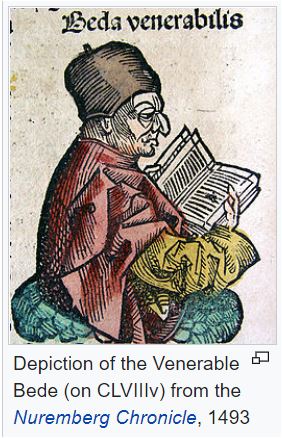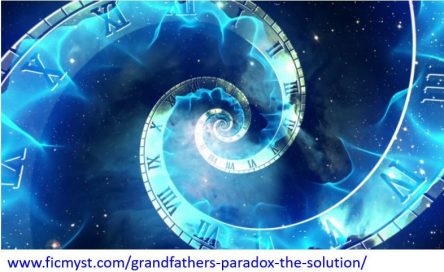
Venerable Bede (Saint Bedae Venerabilis; AD673 – AD735), the English Benedictine monk and scholar known and esteemed to this day, lived and worked in the joint monasteries of St. Peter and St. Paul in the nearby parishes of Jarrow and Monkwearmouth (Northumbria, England). Bede was a versatile scientist, theologian, teacher of poetry and grammar, analyst and translator of ancient Greek and Latin ecclesiastical texts, and church historian.

Even as a young scholar, Bede was concerned with the calculation of Easter dates (Latin: computus paschalis or short computus) and the related analysis of elapsed time (time reckoning) in his work “On Time“. (Original Latin: “De Temporibus“, AD703).
These topics were later treated in detail in his “The Reckoning of Time”; “De Temporum Ratione”; most likely completed in AD725. We call AD725 “Bede’s year”.
In the latter work, Bede refers to a calculation made by the Roman monk Dionysius Exiguus in AD525. We call AD525 “Exiguus’ year”.
To create his Easter table, Exiguus calculated how many years had elapsed since the birth of Jesus Christ. (We will return to Exiguus and the Easter tables).
Exiguus introduced the expression of “Anno Domini”, although the title Dominus (Lord) had been applied to Jesus before.
As reconstructed later by experts, Exiguus found that the year of Jesus’ birth, AD1, corresponds to AUC754, the year calculated since Rome’s founding, and the year of the 195th ancient Greek Olympic Games too. (AUC; see Abbreviations)
Bede initially applied Exiguus’ findings only in compiling his own Easter tables.
In “De Temporum Ratione” and later in his “Historia ecclesiastica gentis Anglorum” (“Ecclesiastical History of the English People“; AD731), Bede dated some historical events relative to the year AD1.
Bede thus used the abbreviation AD and the term Anno Domini in his chronology with the deliberate intention to mark the time reckoning from the year of Jesus’ birth.
It was a new idea in the Christian Era to calculate the years retrospectively for such a long time, and at the same time to show the forthcoming years prospectively, too.
Although, then it took about three centuries for the AD system to become widespread in Europe.
Based on Bede’s works mentioned above, the Roman Christian Church has made AD1 the starting year of our time reckoning, chronology, and calendar for about 1300 years.
Later, this position was also accepted by historians and the states of Europe, and it is used today worldwide.
I mention only very “quietly” that some professional historians and calendar experts (who know more about it than I do) disagree with the scientifically accepted year of ancient historical events. But understandably, they don’t say that. So, the “possible falsehood” of the AD time reckoning is mainly the subject of investigations by some “amateur researchers”. Three of them will be briefly presented below.
According to the different theories, falsehood in the AD time can happen in different ways:
- by intentional falsification, or
- by an error that was later recognised but concealed, or
- by a misinterpretation, and the mistake was not identified earlier.
I have been interested in history, chronology, and ancient calendars for a long time, so I was astonished by the claims of amateur researchers and investigated three theories in detail.
I was intrigued by some of the plausible claims of the three best-known “calendar faking” theories but found all three approaches unacceptable and rejected them.
At the same time, I did not find the refutations of these three theories completely convincing.
To clear up my uncertainties, I had the only opportunity to work out my own (initially playful and self-serving) refutation of the three time-faking theories.
I found a historical contradiction in the late antiquity supported by an old Coptic legend. I call this contradiction “The Coptic Paradox“. (See later.)
The Coptic Paradox, as a conjecture, has helped to refute the three theories. But to my great dismay, my refutation became a reinterpretation of the AD system, a new, shocking hypothesis. As far as I know, the creation of new hypotheses is usually preceded by a conjecture, a preconception of the author. In my case, it was the other way round. I wanted to prove that the calendar could not be falsified. The result is that the error of our AD time reckoning cannot be ruled out.
In my opinion and my new hypothesis, it is possible that our AD era is incorrect. The history of the AD era may contain 220 inserted years.
This inserted period can mean two things: on the one hand, unreal, untrue, fictitious historical events which never took place, and on the other hand, sequences of events that did take place but were described as extended or doubled in time.
At first, I believed my hypothesis was false since it did not meet the essential astronomical criteria, the counterarguments, used to disprove earlier theories.
At the same time, I suspected that the astronomical refutations of the three theories, which appeared to be accurate, might also be inaccurate.
I have briefly explained the essence of my hypothesis to the astronomer Albert Gesztesi. In astronomical terms, Albert considered it possible that the AD time had been miscalculated or falsified even by centuries! He called my attention to the Stellarium sky simulator program, an excellent software tool for astronomical analysis. I took this as encouragement, and I thank Albert again very much. After this background, I started to “learn a little astronomy”.
Astronomy showed the same results as my original thought process based on a historical paradox and legend.
In the following, I illustrate and confirm my new hypothesis mainly with this astronomical train of thought and calculations by analysing data of some selected historical events:
- I approached some astronomical facts with an “unusual perspective”. I found that precisely 220 fictitious historical years can be inserted into the time calculation “in an astronomically difficult to realise way” (see later).
- Since my doubts nevertheless remained, I recalculated the dates of some ancient historical and evangelical events. An astronomical comparison of the recalculated, new dates with the currently accepted historical dates showed that my hypothesis deserves further investigation.
- My new hypothesis results, so to speak, in an “automatic solution” to the well-known calendar issue, the “Gregory’s dilemma”. (See Explanations)
